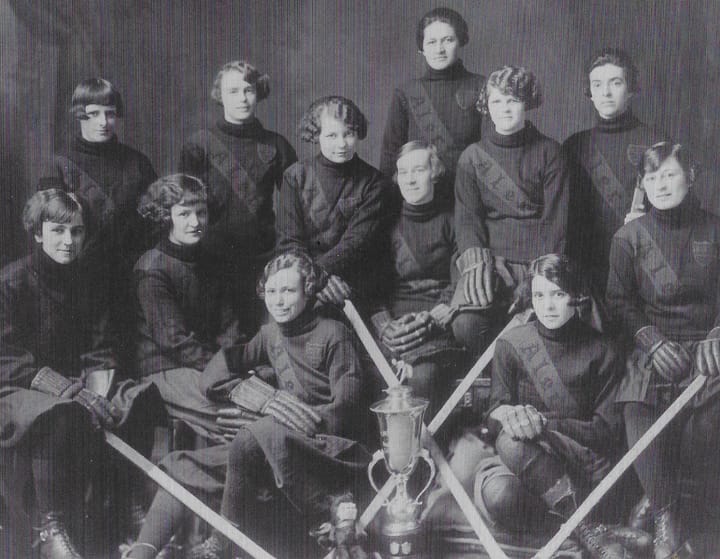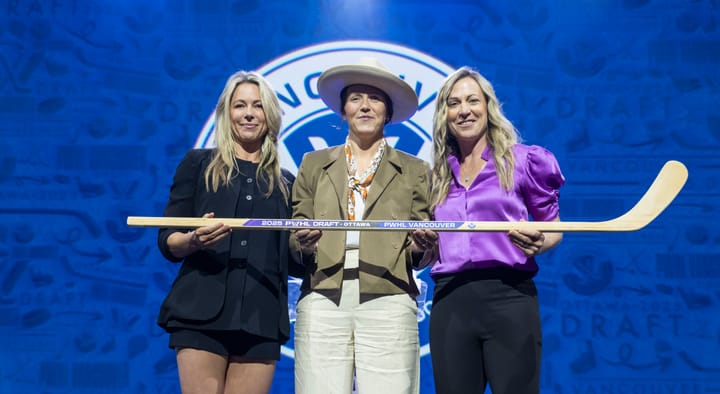The Top 2018-19 Freshman Seasons, Pt. 2
This time around we’re looking at a big center, a big goalie, and a 5-foot-1 defender
Today, we’re continuing our series of the top freshman performances from the 2018-19 season. This time around we’re turning the spotlight on a big center, a decorated defender, and one of the best young goalies in the world.
- Part 1./
Gabbie Hughes | Minnesota Duluth
Gabbie Hughes was a standout freshman this year not just because she is a physical 5-foot-9 center, but also because she was the third freshman in UMD history to lead the team in scoring. She also led all WCHA freshmen in goals per-game (G/GP) and points per-game (Pts/GP) and was one of just seven freshmen centers who took over 600 faceoffs.
Another look at Gabbie Hughes 17th goal of the season for @UMDWHockey.... pic.twitter.com/Qzj3QbXf8f
— UMD Athletics (@UMDBulldogs) March 1, 2019
Hughes started the 2018-19 season off by scoring two goals against the Minnesota Whitecaps in an exhibition game, and then she just kept on rolling. She finished the season leading the Bulldogs in goals (19), assists (18), and power play goals (3). So, it came as no surprise when she was named the team’s MVP on May 9. Even though she played in front of Maddie Rooney, it was clear that Hughes was UMD’s headline player.
“Her success is not a surprise,” UMD head coach Maura Crowell said of her star freshman back in February. “She’s a name in Minnesota that everyone knows about.”
At times, Hughes was a one-woman highlight reel. Her wingspan and quick hands combined with her powerful stride made her surprisingly elusive. Hughes scored a lot of gorgeous goals this year, many of which were created by her dangling through the opposition.
@hughes_gabbie Goal deserves to be on Sports Center top 10!!! @sctop10 pic.twitter.com/Sfc2WK1rmo
— Ashton Bell (@Abell17Bell) February 3, 2019
A few freshmen had better boxcar stats than Hughes this year, but only Northeastern’s Alina Müller shouldered a comparable burden for her team’s offense. A remarkable 32 of Hughes’ 37 points were primary; Anna Klein finished as a distant second on the Bulldogs in with 12 goals and nine primary assists. Without a potent power play to depend on, the bulk of UMD’s offense was tied directly to what Hughes was able to do on any given night.
Cayla Barnes | Boston College
The 2018-19 campaign was a major disappointment for Boston College, and the recent report that 2018 Patty Kaz winner Darryl Watts is leaving the program has only made matters worse.
Fortunately for the Eagles, redshirt freshman Cayla Barnes emerged as the clear successor to superstar defender Megan Keller this year. It’s not easy to stand out when you’re one of three players on your collegiate team’s blue line with an Olympic gold medal, but the two-way defender found a way to make her mark.
Barnes led all freshmen defenders in scoring with four goals and 19 assists in 39 games. She demonstrated an ability to move the puck that should make her a staple on BC’s top power play unit moving forward. Barnes and Keller finished tied for fourth in the nation among defenders in primary assists (12) despite the fact that Keller saw the lion’s share of the ice time.
The 5-foot-1 defender had less opportunities to make an impact on the power play than Keller, but she still carved out an important role for herself in BC’s offense. The 109 shots she put on net this year was good for the second in the nation among freshman D. Furthermore, Barnes played in just three games without registering a shot on net.
Like fellow BC alumna Emily Pfalzer, Barnes plays a lot bigger than her size. She’s a tenacious and fearless defender who seems to relish puck battles. She was sent to the box 22 times this year — which is an aspect of her game that she will want to work on — and finished second on her team in PIM. More importantly, she led the Eagles in blocked shots and finished third in the nation among freshmen skaters in that category.
Lindsay Reed | Harvard
Back in December, we named Lindsay Reed one of the top five goalies in the nation after the stellar start to her collegiate career. Her play in the 16 games that followed that piece only solidified her place as one of the most promising young goaltenders in the world.
This year Harvard’s 2.31 G/GP was ranked 21st in the nation and, on average, they were out-shot by six shots a game. In other words, the Crimson needed Reed to be outstanding, and she didn’t disappoint.
“Honestly, it’s fun,” Reed recently told The Harvard Crimson. “That’s really what it comes down to... Knowing that these teams are coming in, and they’re going to take 50 shots, to see them get frustrated and not scoring, in the end, that’s just fun.”
The 2019 ECAC All-Rookie Goaltender took the conference and the nation by storm in her freshman season. Reed’s quick pads, remarkable athleticism, and 6-foot-0 frame made her a frustrating puzzle that opposing offenses struggled to solve all year long. She set a new program record with the 927 saves, many of which came attached to exclamation points.
Look at that save! @SportsCenter, @ESPNAssignDesk, have you missed Lindsay Reed? #SCTop10#GoCrimson pic.twitter.com/qnL235psex
— Harvard W Hockey (@HarvardWHockey) February 9, 2019
Reed made at least 30 saves 17 times this season and posted a save percentage lower than .900 just four times in her 27 starts. Her .940 save percentage at the end of the year led all freshmen goaltenders. Keep in mind that she posted that .940 save percentage while facing an average of 36.46 shots against per 60 minutes (SA60). That is an avalanche of shots. Minnesota State’s Abigail Levy was the only other freshman goaltender who was even in the same neighborhood as Reed in terms of workload and shot volume.
In February, the New Jersey native led Harvard to its first Beanpot Final since 2015. She made 51 saves against BU in the final, but couldn’t make the 52nd in overtime. Before, after, and during the Beanpot, Reed was one of the two most dominant goaltenders in her conference this year. She had a dazzling .946 save percentage against other teams in the ECAC.
It’s still early, but Reed already has all the tools she needs to become a truly elite goaltender at the international level. It looks like she’s already started down that path. Last month, Reed was one of just 10 goaltenders who attended USA Hockey’s goaltending development camp.
All data courtesy of USCHO.com, HockeyEastOnline.com, gocrimson.com, umdbulldogs.com, and bceagles.com.





Comments ()